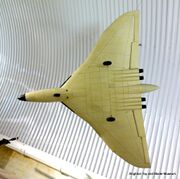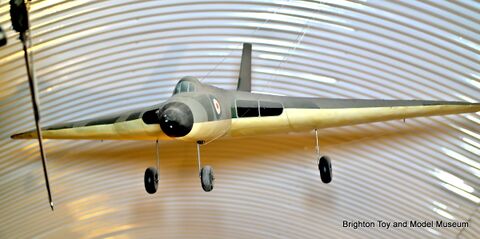Vulcan V-bomber radio controlled model (Denis Hefford)
| Exhibit |
|---|
Vulcan V-bomber radio controlled model (Denis Hefford) (i) (i)
|
 |
| location: |
A radio-controlled model of the British Avro Vulcan V-bomber, overhead in Arch Two, near the entrance.
The model was built by Denis Hefford, and its wingspan is 66 inches.
In flight
Due to the difficulty of powering a radio-controlled model with a real set of jet engines, this model aircraft was originally fitted with a rather sneaky propeller fitted to its nose, the idea being that when the aircraft was flying, the fast-moving blades wouldn't be visible. The anomalous blades have been removed for static display.
The original aircraft
The "Vee" delta-winged Vulcan was probably the best-known of Britain's V-bombers (the others being the Vickers Valiant and the Handley Page Victor), and it was arguably the central feature of the 1965 James Bond film Thunderball, which showcased the interiors and exteriors of a Vulcan in three different contexts ... on the ground, in the air, and then ... underwater, as the Bad Guys camouflage the underwater plane, the Good Guys try to find it, and then both sides fight over the contents.
The Vulcan was powered by four Rolls Royce Olympus turbojet engines embedded in its wings. The Olympus engine was developed for the Vulcan, was later further developed to power the cancelled TSR-2 supersonic strike bomber, and then ended up being used to power Concorde.
Although the Vulcan was developed as a nuclear bomber aircraft, its capacity and range allowed some to be converted as refuelling planes. The range also allowed Vulcan B2's to be used (with conventional weaponry) during the Falklands conflict in 1982.
External links
- A scrollable, zoomable 360-degree view of the inside a Vulcan cockpit (kenmcbride.com)
- Avro Vulcan Gallery (wingweb.co.uk)
- Vulcan Bomber Shop (vulcanbombershop.com)
- Avro Vulcan Cold War Archive
- (Vulcan) XM655 Maintenance and Preservation Society (xm655.com)
- (XL426) Vulcan Restoration Trust, London Southend (avrovulcan.com)
- Vulcan XH558 Appeal (vulcantothesky.org)
- Vulcan History (thunder-and-lightnings.co.uk)
- The Vulcan Bomber blog
Video



